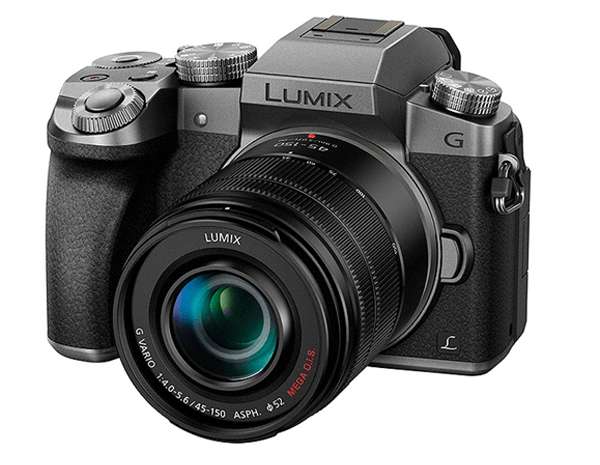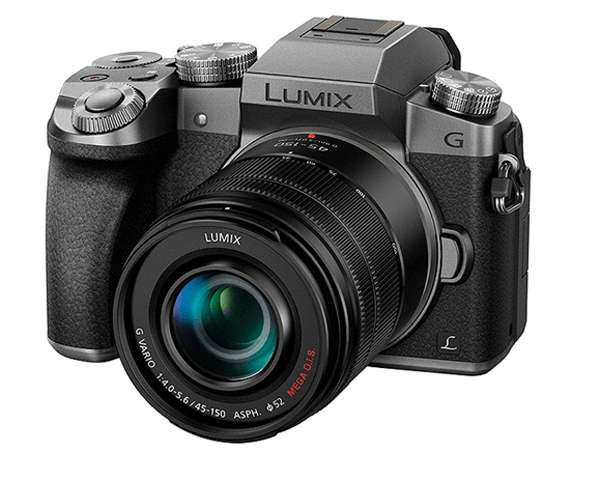By Mason Resnick
A new image processor and souped-up autofocus turn this Panasonic’s new prosumer hybrid camera into a speed demon.
The Panasonic Lumix G7 is the new flagship consumer-oriented interchangeable-lens camera made by the electronics giant, but it borrows key features, most notably 4K video capture, from its pro-oriented sibling, the Panasonic GH4. Unlike the GH4, which aspires to be a serious videography tool, the G7 treats 4K as both a video recording platform (stripped down; it only records 4K in MP4) and notably as a still photography burst mode capture feature.

The G7 has a newer 16MP sensor and many upgrades that will appeal to serious photo enthusiasts. Its DSLR-like design has been overhauled, and ergonomics have been tweaked. But it aspires to be, first and foremost, a camera that can capture the action easily. Several new and tweaked features make this possible.
I had the opportunity to get my hands on an early production G7 and take it for the spin on the streets of New York. Is it as impressive as it sounds? Read on!

Key Features
• Redesigned 16MP Live CMOS Four Thirds (17.3x13mm) sensor
• 4K Video capture at up to 30p in MP4 format, up to 1080p/60fps in AVCHD
• Built-in Wi-Fi, NFC, QR code reading
• 2360k EVF Viewfinder with 100% field of view
• 1040k flip-out, touchscreen LCD monitor
• 1728-zone multipatern metering
• ISO range 200-25,600
• Built-in Flash

Panasonic G7 vs. G6
Panasonic has upgraded several key features and capabilities in the G7 over its predecessor, the G6. Let’s take a quick look at the key changes.
Sensor: While it’s still 16MP, the G6’s sensor was several years old and was the same one found in the GH2. The G7’s sensor is newer; it’s the same one that debuted last year in the GX7.
ISO range: increased from the G6’s 160-12800 to the G7’s 200-25,600.
Image Processing Engine: The new generation Venus Engine 9 replaces version 8
Finder: Resolution is almost doubled, from 1440k to 2360k dots.
AF Speed: While full-frame image capture has a minor increase, from 7 to 8fps the new 30fps 4K burst shooting mode is a boon for action photography. When it comes to stills, the G7 treats 4K as another drive mode.
Video: Resolution gets a major bump up from full HD to 4K when shooting MP4 format.
Ergonomics: Panasonic has added a handy new Drive Dial.
What stays the same: Focus peaking, HDR, WiFi, 60-1/4000 sec shutter speed, and internal flash.

Panarama worked seamlessly at the intersection of 5th Ave., Broadway and 23rd Street in Manhattan, just a few blocks from Adorama headquarters.
Hands-On Field Test
Panasonic applied its G-series DSLR-like design to the G7 in a new way, giving its sloping angles harder edges that give the camera a more modernist design while promoting a comfortable hold via the generously-sized right-hand grip. The camera feels light and comfortable in the hands, and controls are logically laid out and within easy reach without feeling cramped.
Panasonic updated the EVF to 2,360k dot resolution. That’s the sharpest EVF currently available, and indeed the eye-level view is spectacular. I found there to be no hesitation or lag when panning the camera, and the image was just about as clear as what you’d find in an optical finder. The 3-inch, 1040k dot resolution LCD monitor, likewise, displayed a clear, sharp image in almost all light. In direct sunlight the image was more visible than typical LCD images. The touchscreen was responsive and reliable. The Fn5 function button lets you toggle between EVF and LCD monitor.
But what really impressed me about the Panasonic Lumix G7 was its responsiveness. Panasonic has upgraded the image processing engine to a Venus Engine 9 and revved up the AF engine. They claim AF capture is now 0.07 sec, and indeed the image snapped into focus the moment I pressed the shutter release halfway. When I shot in manual focus and exposure, I found there to be no perceptible lag time. As you’ll see below, this made the G7 a great camera for street photography, but this feature also means the camera would be a great choice for sports and action shooting as well.

While shooting 4K video I pressed the shutter release to mark this frame as a still image. This is a great feature when you know the shot’s coming, but are not sure when exactly.
Just like its predecessor, the G6, the G7 captures 4K video. But Panasonic has given it some impressive new tricks. 4K burst and 4k Photo modes are useful for ongoing action capture: In 4K Photo, you hit the movie button to start and stop recording, and the shutter button to mark the best moment as it happens, pulling out a still image. In 4K Burst, press the shutter button to capture a sequence of 4,000-pixel stills in rapid sequence. This is great for casual sports photography. There’s also a 4K pre-burst mode which captures a few frames starting 1 second before and one second after you press the shutter release.
Panasonic claims 8fps burst rate but 8fps with autofocus on, which I think is correct. I found that when shooting RAW+JPEG I was able to get about 7-10 frames before the buffer started to fill up and the frame rate slowed down.
The camera has five Fn (function) buttons, each of which can be programmed to do one of dozens of other tasks. By assigning a new function, you can bring your most-used modes and settings to your fingertip. Speaking of fingertips, the thumb and forefinger control dials were very helpful for quickly setting aperture and shutter speed when I was shooting in manual exposure mode.
Finally, Panasonic adds a new Color Tracing and Direction Vector technology which almost instantly calculates and predicts the future position of a subject based on the previous frames. In the field, I found that fast-moving objects remained in focus through a sequence. So basically, it works.
After shooting at a range of ISOs, I was quite pleased with the results.
Street Photo Stress Test: Few picture-taking situations pushes a camera’s envelope like capturing the chaos of people on the streets of New York. The G7 aced this test! Here are a few sample photos show during a lunch hour in the Photo District.

Fantasy mode gives a foggy, pastel feel.

We love Miniature mode, don’t we?

High dynamic range brings out the intricate details in the shadow of the Flatiron building.

Conclusion and Recommendation
The Panasonic Lumix G7 is a fast, responsive, hybrid photo/video capture machine. If you plan on shooting lots of sports and action, fast-moving kids or pets, as well as candids or street photography, this camera is worthy of your serious consideration. It packs a lot of features and quality.
* Update (7/14/2015): This camera is now available at Adorama for $1,097.99 with a 14-140mm lens and $797.99 with a 14-42mm lens,



